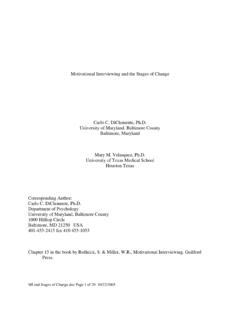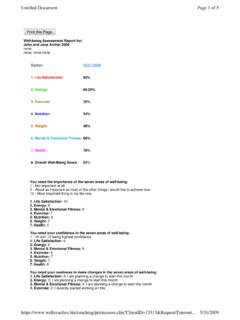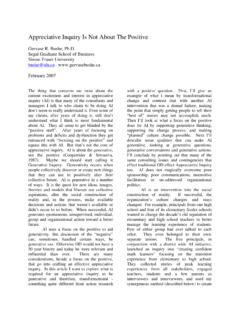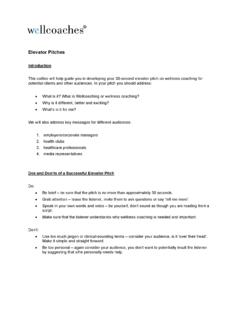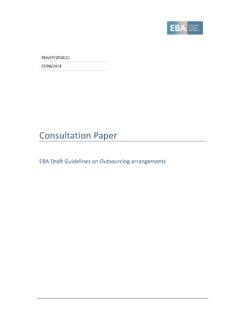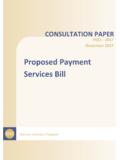Transcription of Chapter 10: Conducting Coaching Sessions - Wellcoaches …
1 confidential Page 1 of 43 03/02/2009 Chapter 10: Conducting Coaching Sessions confidential Page 2 of 43 03/02/2009 Chapter 10 Conducting Coaching Sessions Good fortune is what happens when opportunity meets with planning. Thomas Alva Edison Chapter Contributors: Margaret Moore, Erika Jackson, Bob Tschannen-Moran, and Gloria Silverio After reading this Chapter , you will be able to: Identify and discuss the guidelines to follow during an initial 45-90 minute vision and planning Coaching session Outline the Coaching Contract Use the Coaching Vision Tool to assist clients to develop their wellness, fitness, or health visions Identify and discuss the guidelines to follow during a weekly 20-45 minute Coaching session Identify expectations for the first three months of Coaching Demonstrate how to document first session notes Demonstrate how to document subsequent session notes confidential Page 3 of 43 03/02/2009 INTRODUCTION Among the ICF Core Coaching Competencies is Managing Progress and Accountability (see Chapter 2), enabling clients to move from Point A, where they are today, to Point B, where they want to go.
2 There are many approaches to the design and process of Coaching programs and Sessions that facilitate movement to Point B. Wellcoaches has developed, practiced, and refined over many years a structure for Coaching Sessions which has proven highly effective and provides a valuable hand-rail for new coaches. There is never only one way in Coaching , yet clients, not just coaches, enjoy structure as a means to gain mastery in change. As coaches gain experience, they can modify the process of Coaching Sessions in ways that maintain engagement for themselves and their clients. STEP-BY-STEP GUIDELINES FOR THE FIRST 45-90 MINUTE Coaching SESSION (CREATING A VISION, THREE-MONTH GOALS, AND FIRST-WEEK GOALS) As discussed in Chapter 8, the initial Coaching session sets the tone for the entire Coaching relationship both by establishing trust and rapport and by creating the vision and goals a client will work on for weeks and months to come.
3 Because the initial Coaching session carries so much weight and covers so much ground, it takes longer than subsequent Coaching Sessions and may last for as long as 90 confidential Page 4 of 43 03/02/2009 minutes. It can also be broken up into two 40 minute Sessions . The checklist in Figure identifies the flow of an initial Coaching session. FIGURE Initial Coaching Session Checklist Action BEFORE THE SESSION Review the Assessment: Seek out success, notice areas with heightened arousal, consider stages of change, question gaps, note concerns Practice Mindfulness Remember to use the key Coaching skills: Mindful Listening, Inquiry and Reflection Formulate initial, strengths-based inquiries SESSION OPENING Welcome and thank you Thank client for completing an assessment Introduction of Coach: Share personal passion, credentials, and experience if not already completed in a prior consultation Review and get agreement on the Session Agenda.
4 Confirm client expectations and priorities, gather additional information, create vision, design goals EXPECTATION SETTING (if not done in a prior consultation) What is Coaching Confidentiality Record keeping Establish Coaching Contract DISCUSS ASSESSMENT Find something positive to share from the client s assessment Ask client what s/he learned about him/herself by completing the assessment Ask client what questions s/he has after completing the assessment Gather missing information Discuss client's medical history and need for physician release, if applicable CREATE A VISION Explain the value of creating a vision Ask what is most important to the client right now Collaborate to identify the client strengths: Review success stories, discuss what is working now, discover what gives the client pride Discover the client's motivators.
5 Ask about the benefits of making changes now, ask about the driving force behind the desire to change now confidential Page 5 of 43 03/02/2009 Action Ask about the client's vision (hopes, wishes and dreams) for health, fitness, or wellness Support the client in visualizing his/her vision and describing it in detail Use confidence ruler to assess and improve self-efficacy Ask what challenges would be met and what things would be possible if the vision were a reality Discover previous positive experiences with elements of the vision Identify the strengths and values that could be used to reach the vision Explore the support (people, resources, systems, and environments) needed to ensure success and handle challenges Ask the client to state and commit to the vision DESIGN THREE-MONTH GOALS Explain the nature and value of setting three-month goals Brainstorm consistent behaviors that would lead to the achievement of the vision Ask the client to choose several behavioral goals that are most important to pursue Confirm the connection of the behaviors to the vision Assist the client in developing SMART behavioral goals DESIGN FIRST WEEK'S GOALS Ask the client to choose goals that are important next steps toward three month behavioral goals Assist the client in designing SMART behavioral goals Use confidence ruler to improve the client's confidence in reaching the goal Explore the client s strengths and support (people, resources, systems, and environments)
6 Needed to ensure success and handle challenges Ask the client to restate and commit to SMART goals Affirm the client's ability to achieve the goals SESSION CLOSE Express appreciation for the client's work Discover and reflect what the client learned Confirm that the client is ready, confident, and committed to take agreed upon actions. Ask for feedback on how future Coaching Sessions would best support the client's path Clarify expectations regarding payments, scheduling, rescheduling, and length of Sessions Schedule the next session confidential Page 6 of 43 03/02/2009 SECTION-BY-SECTION CONSIDERATIONS The initial planning session is the most important session in the Coaching process. Your client will form a first impression which will be lasting. BEFORE THE SESSION Get yourself into the right mindset The most important minute of a Coaching session is arguably the minute right before it starts.
7 That s when coaches and clients clear their minds, set their intentions, and get into the Coaching mindset. Relaxation exercises can assist coaches to be completely present and client focused. Before the session, remind yourself of these key points: Confidence is contagious. The more we communicate our certainty that clients can be successful, the more likely it is that clients will be successful. What do I believe is possible, now? What we appreciate, appreciates. The more we focus on what clients want, rather than on what they don t want, the more energy and ideas clients will have for moving forward. What do I want to appreciate, now? Listen until I don t exist. The more we set aside our own agenda, in favor of listening for the client s agenda, the more clients will discover about themselves and discern their own answers. What do I want to listen for, now? confidential Page 7 of 43 03/02/2009 Tell the truth.
8 The more we reveal clients to themselves, through empathy and honesty, the more progress they will make toward their vision. Don t be afraid to share what it is there. How do I want to connect, now? Trust my intuition. The more deeply we listen to our own instincts and inklings during Coaching conversations, the more deeply clients will connect with their instincts and inklings. That s what leads to the intuitive dance of Coaching . What is my gut saying, now? SESSION OPENING Establish Trust & Rapport It is important to make clients feel comfortable at the outset. Be friendly, warm, respectful, confident, and purposeful. Thank your clients for the privilege of being their coach and for the time they took to complete any pre-session assessments. Express confidence in their ability to reach desired goals and your ability to help them. Ask a few basic, get-to-know-you questions such as occupation, family, hobbies, physical activities they enjoyed as a child, or daily routine.
9 Find an area of commonality, if you can, and mention it. Express empathy if clients appear uncomfortable. The key is to create a relational space in which trust and rapport can grow. Until that happens, the results of inquiry will be superficial and the potential of Coaching to generate transformational change will not be realized. Introduce Yourself Briefly share with clients your biography, if you haven t already done so. Avoid talking too long or too much about yourself. Ask whether they have any questions about your background. Before beginning the Coaching session, ask: "What more do you want to know about me before we begin?" confidential Page 8 of 43 03/02/2009 When introducing yourself, convey your passion to your client, as well as describe your education and experience. Be sure to speak from your heart, rather than read from a paper. Clients can tell when you are reciting lines, and it does not sound genuine.
10 Describe your Objectives for the First Coaching Session The first session is an opportunity to gain a good understanding of your client s history, strengths, and goals, as well as to build a vision and plan. Explain to clients that your objectives for the first Coaching session are: a) to learn more about their priorities, strengths, goals, motivators, challenges, and resources; and b) to help them develop a plan, including a vision, three-month behavioral goals, and several first-week goals. Have your clients confirm that this is acceptable, and address any additional questions or concerns they may have. EXPECTATION SETTING Describe the Coach Approach Beginning with the first session, it is crucial that clients realize they are not getting a cookie-cutter approach. Explain briefly to your client the difference between teaching and Coaching . Whereas teachers have information, expertise, and wisdom that they want to share with their students, coaches enable clients to discover a lot of that for themselves.

